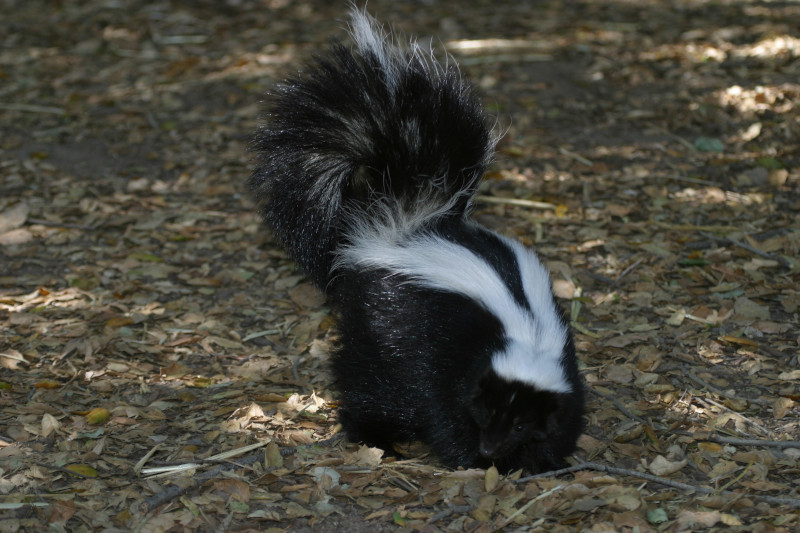
Striped Skunk Facts
- This beautiful small mammal with the very unfortunate reputation most frequently goes by the common name of the Striped Skunk. It does have a few other generally used monikers, though. Those include the distinctive tags common skunk, northern skunk, and prairie polecat.
- Within the scientific community, however, it’s perhaps more frequently referred to by its technical title. That, thankfully remains a relatively comparatively name for the layperson to pronounce. That’s true since the animal bears the official moniker of the Mephitis mephitis.
- The creature received that distinctive formal title due to the efforts of the German naturalist, Johann Christian Daniel von Schreber. The respected researcher accomplished the first recognition of it as a separate and distinct species. He achieved that noteworthy feat in 1776.
- Regardless of which appellation one chooses to employ, the marvel remains one of the most easily recognizable animals in its native range. It’s even become immersed deep in the local culture, appearing as a character in various cartoons. A total of 13 subspecies also exist.
- Fortunately, the remarkable Striped Skunk seems to be maintaining a sizeable and stable population base. That pleasant trend further appears to hold true throughout the entirety of its habitat zone. The IUCN, therefore, now lists it as Least Concern on its published Red List.
- The intriguing creature nevertheless faces some very real potential threats to its continued existence as a species. In this, it finds itself in the same situation as most species on the earth today. It’s endangered by the dual perils posed by habitat loss and ongoing climate change.
Related Articles
Striped Skunk Physical Description
The remarkable Striped Skunk never fails to present the viewer with a captivating appearance. It fully deserves appreciation for the beauty Nature gifted it with. Yet, it’s not an overly large animal, in terms of pure physical size. Nature, however, blessed the mammal with other attributes.
Like many of earth’s fauna, the beautiful animal usually presents a certain degree of the physiological characteristic of sexual dimorphism. In its case, this trait manifests itself in terms of sheer physical measurements. Due to that tendency, the males attain a larger size than females.
That difference remains relatively minor, though. As a general principle, the males grow to about 10% larger than their female counterparts. This includes both weight and length of body. Exceptional individuals do naturally occur, however, completely regardless of their gender.
Overall, individuals attain an average head-to-tail length measuring somewhere between 20.5 – 30.3 in (52 – 77 cm). Body mass also varies accordingly. Specimens therefore typically display weights ranging from 4 – 9.9 lb (1.8 – 4.5 kg). Some of them do reach as much as 12 lb (5.5 kg), though.
The body of the Striped Skunk is perhaps best described as stout in form. It’s limbs develop as relatively short, while it also evolved a small, conical head. The thickly-furred tail typically accounts for about half the overall length. The front feet have long claws, but the rear one’s are shorter.
Yet its the eye-catching color pattern of the animal that grabs the eye first. The precise nature of this varies widely between individuals, but a basic pattern remains. That generally consists of a deep black background, with the well-known white stripe extending from nose to tail tip.
- Kingdom: Animalia
- Phylum: Chordata
- Class: Mammalia
- Order: Carnivora
- Family: Mephitidae
- Genus: Mephitis
- Species: M. mephitis
Striped Skunk Distribution, Habitat, and Ecology
The beautiful Striped Skunk evolved as endemic to a comparatively wide expanse of the surface of our beautiful world. That precise region of the globe doesn’t surprise many people, however. That’s because it developed as endemic to much of what’s presently known as North America.
The majority of its natural zone of habitation includes the entirety of the continental United States. To the north, though, the mammal appears in the approximate southern half of the country of Canada. Southward, the oft-maligned animal lives in a very small part of northern Mexico.
Nature blessed this natural marvel with an impressive adaptability in terms of its habitat choices. Due to that remarkable degree of flexibility, it appears in a wide range of ecosystems. These include such highly diverse regions as rocky outcrops, wooded ravines, and moderately brushy corners.
It does, however, show a moderate preference for areas of mixed woodlands. Its adaptability never ceases to amaze the viewer, though. As a result of human presence, in some regions, such as the state of Illinois, a few populations actually prefer cultivated areas over uncultivated one’s.
It’s the defensive tactics of the Striped Skunk that undoubtedly gather the most attention, though. Two glands near the base of the tail produce an extraordinarily odorous liquid. The animal has the ability to spray this at will for a respectable distance. Due to the strength of this, it has few predators.
It also evolved as principally carnivorous in terms of diet. The animal mostly feeds on various insects, such as grasshoppers, crickets, beetles, and caterpillars. Yet, it sometimes eats eggs, voles, mice, as well as fish and small reptiles. Various fruit, such as berries, also form an occasional treat.
Species Sharing Its Range
Check out our other articles on 5 Marvelous Mediterranean Sea Species, Wilson’s Bird-of-paradise, Deception Island, Kinnikinnick, Blue Orchard Bee, Great Potoo, Mugger Crocodile
